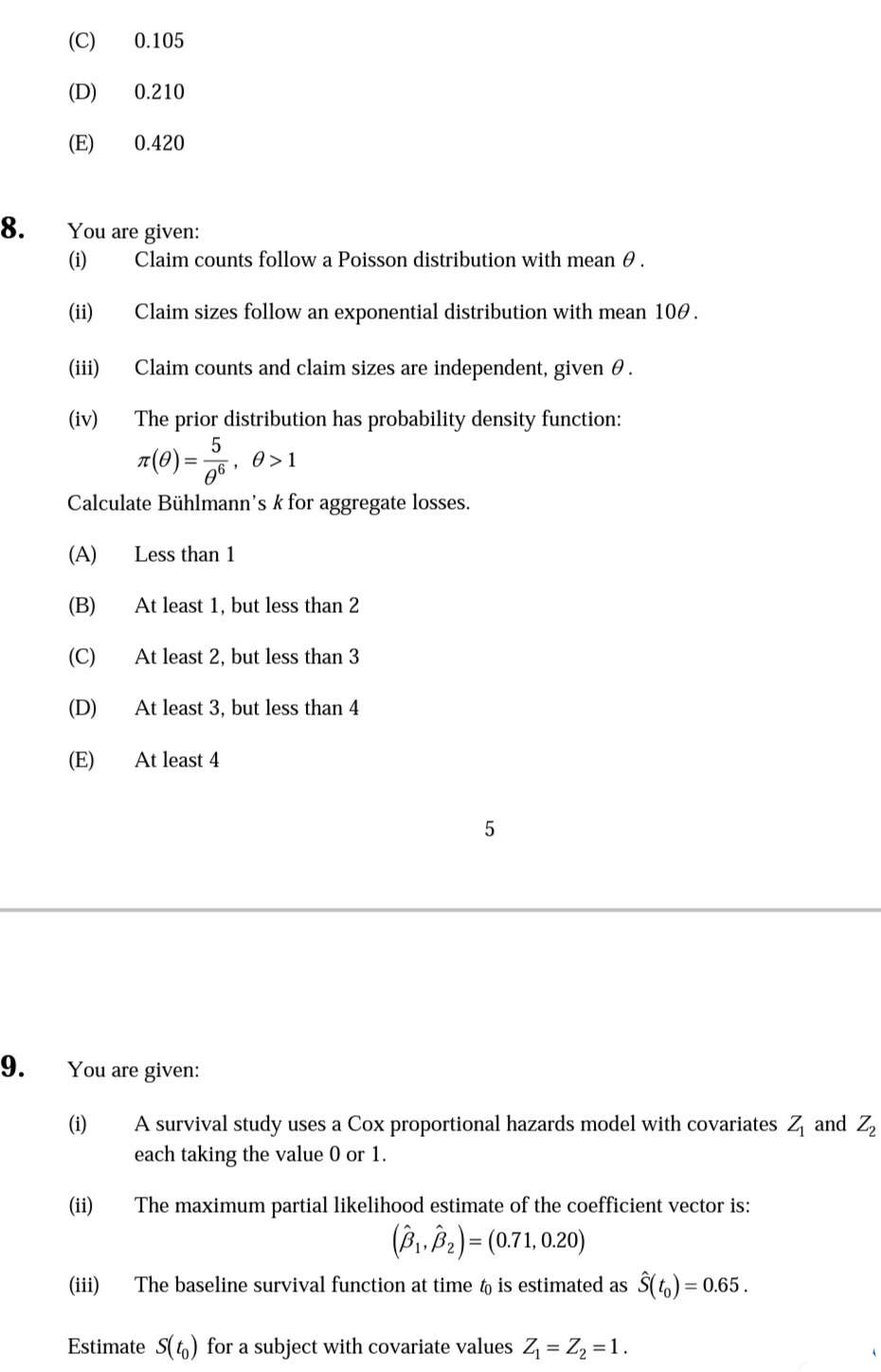Calculate Bühlmann's k for aggregate losses. (A) Less than 1 (B) At least 1, but less than 2 (C) At least 2, but less than 3 (D) At least 3, but less than 4 (E) At least 4 5 LO
Calculate Bühlmann's k for aggregate losses. (A) Less than 1 (B) At least 1, but less than 2 (C) At least 2, but less than 3 (D) At least 3, but less than 4 (E) At least 4 5 LO
MATLAB: An Introduction with Applications
6th Edition
ISBN:9781119256830
Author:Amos Gilat
Publisher:Amos Gilat
Chapter1: Starting With Matlab
Section: Chapter Questions
Problem 1P
Related questions
Question
Q.9.0 please

Transcribed Image Text:(C)
0.105
(D)
0.210
(E)
0.420
8.
You are given:
(i)
Claim counts follow a Poisson distribution with mean 0 .
(ii)
Claim sizes follow an exponential distribution with mean 10.
(iii)
Claim counts and claim sizes are independent, given 0 .
(iv)
The prior distribution has probability density function:
a(0) =-
5
0 >1
06
Calculate Bühlmann's k for aggregate losses.
(A)
Less than 1
(B)
At least 1, but less than 2
(C)
At least 2, but less than 3
(D)
At least 3, but less than 4
(E)
At least 4
5
9.
You are given:
A survival study uses a Cox proportional hazards model with covariates Z and Z
each taking the value 0 or 1.
(i)
(ii)
The maximum partial likelihood estimate of the coefficient vector is:
(Bi, B2) = (0.71, 0.20)
The baseline survival function at time to is estimated as S(t) = 0.65.
(iii)
Estimate S(to) for a subject with covariate values Z = Z2 = 1.
Expert Solution
This question has been solved!
Explore an expertly crafted, step-by-step solution for a thorough understanding of key concepts.
This is a popular solution!
Trending now
This is a popular solution!
Step by step
Solved in 2 steps with 2 images

Recommended textbooks for you

MATLAB: An Introduction with Applications
Statistics
ISBN:
9781119256830
Author:
Amos Gilat
Publisher:
John Wiley & Sons Inc

Probability and Statistics for Engineering and th…
Statistics
ISBN:
9781305251809
Author:
Jay L. Devore
Publisher:
Cengage Learning

Statistics for The Behavioral Sciences (MindTap C…
Statistics
ISBN:
9781305504912
Author:
Frederick J Gravetter, Larry B. Wallnau
Publisher:
Cengage Learning

MATLAB: An Introduction with Applications
Statistics
ISBN:
9781119256830
Author:
Amos Gilat
Publisher:
John Wiley & Sons Inc

Probability and Statistics for Engineering and th…
Statistics
ISBN:
9781305251809
Author:
Jay L. Devore
Publisher:
Cengage Learning

Statistics for The Behavioral Sciences (MindTap C…
Statistics
ISBN:
9781305504912
Author:
Frederick J Gravetter, Larry B. Wallnau
Publisher:
Cengage Learning

Elementary Statistics: Picturing the World (7th E…
Statistics
ISBN:
9780134683416
Author:
Ron Larson, Betsy Farber
Publisher:
PEARSON

The Basic Practice of Statistics
Statistics
ISBN:
9781319042578
Author:
David S. Moore, William I. Notz, Michael A. Fligner
Publisher:
W. H. Freeman

Introduction to the Practice of Statistics
Statistics
ISBN:
9781319013387
Author:
David S. Moore, George P. McCabe, Bruce A. Craig
Publisher:
W. H. Freeman